Historical mile Nuremberg
The Historical Mile Nuremberg is a cultural and historical city tour that opens up the most important historical sights of the medieval old town of Nuremberg , which was basically preserved despite the great war damage and is therefore a world-famous tourist attraction.
On the history of Nuremberg
Nuremberg's heyday as an imperial palace , powerful imperial city and international economic center was in the Middle Ages. Its political power as the most important imperial city in the Middle Ages and as a repository of imperial regalia , but also its economic prosperity made the city one of the metropolises in Europe at that time. The Nuremberg Stock Exchange served as a link in trade between Italy and other European economic centers. The wealth of the Nuremberg patricians resulted in a lively artistic, cultural and intellectual life. Well-known Nuremberg artists, poets and thinkers included Albrecht Dürer , Veit Stoss , Adam Kraft , Peter Vischer , Willibald Pirckheimer , Georg Philipp Harsdörffer , Anton Koberger and Hans Sachs . In Nuremberg, Peter Henlein invented the pocket watch, Martin Behaim the globe, and it was there that Schedelsche Weltchronik was created . Even today, numerous buildings, monuments and works of art testify to the former importance of the city.
Although the old town of Nuremberg was more than 90 percent destroyed after the Second World War, the most important historical buildings were restored. The bomb damage to the Nuremberg city wall , the longest surviving wall in Central Europe, was also removed.
On the history of the historic mile
The occasion and purpose of the Historic Mile
The tour through the historic old town of Nuremberg was created in 2000 on the occasion of the 950th birthday of the former Free Imperial City. Editing and design were the responsibility of the historian Carlo Jahn (at that time in the City Anniversary Project Office of the School and Culture Department of the City of Nuremberg, today in the Art and Culture Pedagogical Center of the Museums in Nuremberg, KPZ).
The walk on the historic mile is a touristic tour with a trailblazing sign system that informs visitors to the city about the historical and art-historical past of the city of Nuremberg, guides them through the eventful past of Nuremberg and gives them a first brief impression of the historical sights of Nuremberg's old town and convey their story. In this respect, showing restored and reconstructed historical buildings in Nuremberg's old town is also part of the culture of remembrance.
Professional support
Carlo Jahn secured professional support from Fritz Aschka, Verlag Nürnberger Presse , Nikolaus Bencker, Lower Monument Protection Authority of the City of Nuremberg, the Director of the Nuremberg City Archives and Deputy Chairman of the Association for the History of the City of Nuremberg, Michael Diefenbacher, the historian and head of the Old Town Friends Nuremberg , Erich Mulzer , the municipal traffic director Michael Weber, managing director of the Congress and Tourism Center Nuremberg, as well as at all stations involved.
Stations of the city tour
Along the historic mile, buildings, ensembles and squares that are particularly linked to the history of Nuremberg or represent architectural gems are marked with a sign that shows a black H on a red background and describes the location or structure in short texts. These and other optical markings between all stations guide visitors from one place to the next. Turn-off markings indicate worthwhile destinations outside of the historical mile (“Excursions” 8, 14, 20 and 28). The stations of the Historic Mile are listed and briefly explained below.
| station | image | description |
|---|---|---|
| 1 |
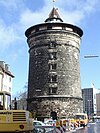
|
City fortifications The five kilometer long city wall was finished around 1400. In the picture the outer Laufer gate tower . |
| 2 |

|
Marthakirche The building from 1385 has been used as a reformed church since 1800 and was only slightly damaged in the Second World War. |
| 3 |

|
Klarakirche The construction, which began in 1270, is one of the oldest preserved churches in Nuremberg and has been used as a Catholic church since 1854. |
| 4th |

|
Toll hall The granary, built between 1498 and 1502, was badly damaged in World War II. The picture shows the view from Hallplatz. |
| 5 |

|
Lorenz Church The building, completed in 1477, is one of the two main churches in Nuremberg and the seat of the Protestant city dean. |
| 6th |
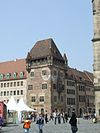
|
Nassau house The last residential tower still in existence in Nuremberg. It found its present form in 1422/1433. |
| 7th |

|
Holy Spirit Hospital The building was built in 1332/39. The imperial regalia were kept there from 1424 to 1796 . It was badly damaged in World War II and rebuilt by 1953. |
| 8th | Excursion in the east of the old town | |
|
8.1 |

|
Synagogue |
|
8.2 |

|
Debt tower |
|
8.3 |

|
Katharinenruine |
| 9 |

|
woman Church The building erected between 1352 and 1362 with the Männleinlauf built between 1506 and 1509 has been used as a Catholic church since 1816. |
| 10 |

|
Main market It was erected in place of the Jewish quarter after a pogrom in 1349 against the Jews. The main market forms the center of the city. |
| 11 |

|
Beautiful fountain It was built in 1385–1396 on the main market square and represents the world view of the Holy Roman Empire on four floors . |
| 12 |
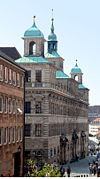
|
town hall The oldest part with the Great Hall was built in 1332–1340, expanded in the late Gothic style in 1514–1515 and expanded in the Renaissance style in 1616–1622. |
| 13 |

|
Fembo house The merchant's house, built in the late Renaissance style between 1591 and 1596, houses the city museum on Nuremberg history. |
| 14th | Excursion to the north of the old town | |
|
14.1 |

|
Tucherschloss |
|
14.2 |
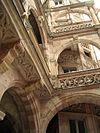
|
Pellerhaus |
|
14.3 |

|
Seven lines |
| 15th |

|
Imperial Castle The imperial castle was built from 1140, and the Luginsland tower in the imperial city area from 1377 . |
| 16 |

|
"Nuorenberc" The rock mountain on which the Nuremberg Castle rises. |
| 17th |

|
Craftsman's cottage Preserved medieval craftsmen's houses along the alley Am Ölberg . |
| 18th |

|
Pilate House Late Gothic house from 1489 on Tiergärtnertorplatz. |
| 19th |

|
Zoo gardener gate The gate tower from the second half of the 13th century was walled up around 1545; a larger gate was built right next to it. |
| 20th | Excursion in St. Johannis (Nuremberg) | |
|
20.1 |

|
Johannisfriedhof (Johannisstraße) |
|
20.2 |

|
Hesperides Gardens |
|
20.3 |

|
Nuremberg Way of the Cross ( Adam-Kraft-Kreuzweg ) |
| 21st |

|
Albrecht Dürer's House Albrecht Dürer lived in the house from the second half of the 15th century from 1509 until his death in 1528. Today the house is a museum. |
| 22nd |
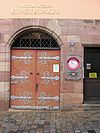
|
Historical art bunker In 1940, in a rock cellar from the Middle Ages, shelters for Nuremberg works of art were set up against air raids. The picture shows the entrance. |
| 23 |

|
Old town ensemble on the Krämersgassen The best preserved parts of today's old town with narrow craftsmen's houses and stately stone buildings. The oldest is from 1395. |
| 24 |

|
Rock passages (Nuremberg) An extensive cellar system has been dug into the rock under the Nuremberg Castle since the 14th century. |
| 25th |

|
Poker house Two houses from the 12th century were converted into a patrician house in 1482/83. |
| 26th |

|
Sebalduskirche The first basilica was built between 1225/30 and 1273, the east building was completed in the 14th century. It is one of the two main churches in Nuremberg. |
| 27 |

|
Sebalder rectory The building was built in 1361/1379. |
| 28 |
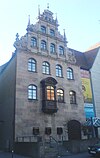
|
Excursus: Hallersches Haus ( toy museum ) The building was built in 1517 as a patrician seat and is used as a toy museum. |
| 29 |

|
Weißgerbergasse Over twenty medieval half-timbered houses survived the heavy bombing raids on Nuremberg. |
| 30th |
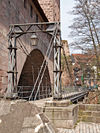
|
Chain bridge In 1824 Germany's first free-floating river bridge was completed; it is also the first iron suspension bridge on mainland Europe. |
| 31 |

|
Weinstadel The building was built as an infirmary in 1446/48 and was later used as a wine store. Today it is a student residence. |
| 32 |

|
Unschlittplatz With its medieval buildings, the square is one of the few preserved historical ensembles in the city. In addition to the Unschlitthaus and a Baroque palace from 1754, there are other houses from the 15th and 18th centuries. |
| 33 |
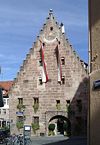
|
Unschlitthaus The granary, built in 1491, later became the seat of the municipal monopoly administration for Unschlitt . Today there is a pawnshop and a municipal office. |
| 34 |

|
Hangman's Walk In 1457 the covered walkway was built over the Pegnitz. |
| 35 |

|
At the meat banks A new building was built on the foundation walls of the meat market hall built in 1570/71. Today only the so-called ox portal, the entrance gate to the meat shop , remains . |
literature
The brochure accompanying the “Nuremberg Historical Mile” linked below contains short texts with explanations, dates and anecdotes on the origins and history of the buildings. It is available in German and English.
- Brochure accompanying the Historic Mile Nuremberg - PDF
- Accompanying brochure in English - PDF
- Wilhelm Schwemmer (Ed.): That's how it used to be. Nuremberg in the 17th century. Copper engravings by Johann Alexander Böner (1647-1720) , Nuremberg: Verlag Nürnberger Presse, 1968, 67 pp.
- Wilhelm Schwemmer: Nuremberg as it was. An illustrated book . Düsseldorf: Droste-Verlag, 1972, 102 pages, ISBN 3-7700-0304-7
- Christian Conrad Nopitsch (Ed.): Guide for strangers in Nuremberg, or topographical description of the imperial city of Nuremberg according to its squares, markets, alleys, alleyways, courtyards, spiritual and secular public buildings, brought into alphabetical order . Unchanged reprint of the Nuremberg edition, Raspe, 1801. With an afterword by Peter Fleischmann. Neustadt an der Aisch: Verlag für Kunstreproduktionen Schmidt, 1992, IV, 250, 57 S., ISBN 3-923006-86-1
- Herbert Maas: Book review Christian Conrad Nopitsch (ed.): Guide for strangers in Nuremberg , ... Neustadt an der Aisch: 1992. In: Communications of the Association for the History of the City of Nuremberg Volume 80, 1993, p. 272 f. - online
- Günther P. Fehring and Anton Ress (†): The city of Nuremberg . 2nd edition, edited by Wilhelm Schwemmer. Munich; Berlin: Deutscher Kunstverlag, 1977, unaltered reprint 1982, 599 pages, ISBN 3-422-00558-7 (Bavarian art monuments; 10)
- Erich Mulzer: City Guide Nuremberg. City tour with information on the sights. Tips and information . 1st edition. Freiburg: Rombach 1984, 104 pages, ISBN 3-7930-0376-0 ; 4th renewed edition. Freiburg im Breisgau: Rombach, 1987
- Baedekers Nuremberg. City guide [Erich Mulzer]. By Karl Baedeker. Strong adult Edition. Freiburg im Breisgau: Baedeker, 1986, 126 pages, ISBN 3-87954-024-1 ; 9th edition 1996, Baedeker Nuremberg. City-guide; Ostfildern-Kemnat: Baedeker; Reprint, 2000, 134 pp.
- Michael Diefenbacher , Rudolf Endres (Hrsg.): Stadtlexikon Nürnberg . 2nd, improved edition. W. Tümmels Verlag, Nuremberg 2000, ISBN 3-921590-69-8 ( online ).
- Fritz Aschka and Toni Burghart (eds.): Nuremberg. The new millennium begins . Foreword: Lord Mayor Ludwig Scholz , text: Fritz Aschka, drawings and texts: Toni Burghart, photographs: Lajos Keresztes. Nuremberg: Verlag Nürnberger Presse, 2000, 343 pages, ISBN 3-931683-05-2
- Gustav Roeder: Full of fine arts - Nuremberg's 950 annual rings . In: Mitteilungen der Altnürnberger Landschaft eV, Volume 49, 2000, Issue 1, pp. 417–424.
- Peter Zahn: Nuremberg in the 950th year. Historical publications on the city anniversary . In: Communications from the Association for the History of the City of Nuremberg, Volume 87, 2000, pp. 119-157 - online
- Erik Stecher: City tour along the historic mile. Rediscover the beauties of the city . In: Nürnberger Zeitung No. 100 of May 1, 2007, Nürnberg plus, page + 1 - online
- Fritz Aschka: My Nuremberg . Nürnberg: Verlag Nürnberger Presse, 2007 [contains 60 history walks by the journalist of the Nürnberger Nachrichten since 2004]
- Paul Johann Anselm von Feuerbach, Everyday Life in Old Bavaria. Historical criminal cases from Bavaria a. a. from Nuremberg. Introduced, selected and retold by Gerold Schmidt. Norderstedt 2006 ISBN 978-3-8334-6060-9
See also
- Art and architectural monuments of the city of Nuremberg
- Castles, palaces and mansions in the city of Nuremberg
- Documentation center Nazi party rally grounds
Individual evidence
- ^ KPZ - Art and Culture Education Center of the Museums in Nuremberg
- ↑ Building Department - Lower Monument Protection Authority
- ↑ Michael Diefenbacher, director of the Nuremberg City Archives, with portrait photo
- ↑ Dr. Erich Mulzer - the "old town maker". In: altstadtfreunde-nuernberg.de. Altstadtfreunde Nürnberg eV, archived from the original on July 25, 2013 ; accessed on October 3, 2017 .
- ↑ Michael Weber, City Traffic Director and Managing Director of the Nuremberg Congress and Tourism Center, with a portrait photo

